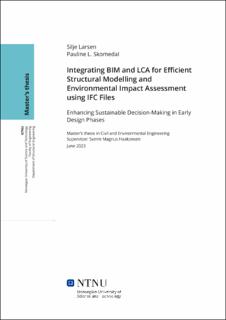| dc.contributor.advisor | Haakonsen, Sverre Magnus | |
| dc.contributor.author | Larsen, Silje | |
| dc.contributor.author | Skomedal, Pauline L. | |
| dc.date.accessioned | 2023-09-20T17:20:44Z | |
| dc.date.available | 2023-09-20T17:20:44Z | |
| dc.date.issued | 2023 | |
| dc.identifier | no.ntnu:inspera:146720801:34551023 | |
| dc.identifier.uri | https://hdl.handle.net/11250/3090915 | |
| dc.description.abstract | Det er enighet blant eksperter om at byggesektoren er en betydelig bidragsyter til globale CO2-utslipp. Ettersom fokuset skifter mot miljøpåvirkningen fra nye bygninger, har bygge bransjen begynt å implementere verktøy for å kontrollere og måle miljøpåvirkningen fra prosjekter. Å undersøke CO2-utslipp er en effektiv og målbar tilnærming for å vurdere ulike løsninger.
I moderne byggeprosjekter er Bygningsinformasjonsmodeller (BIM) mye brukt, der man starter med begrenset informasjon i de tidlige fasene og gradvis øker detaljnivået utover i prosjektet. Vurderingen av utslippene involverer ofte en Livssyklusanalyse (LCA), som analyserer bidraget fra ulike bygningselementer til utslippene. Bruk av visuelle programmeringsspråk i den tidlige designfasen kan være en optimal tilnærming for å integrere BIM med LCA.
Denne masteroppgaven har som mål å utvikle en metodikk som effektivt prosesserer en BIM-modell som inndata, analyserer den statiske modellen, optimaliserer tverrsnittene og identifiserer til slutt løsninger med lavest mulig LCA-fotavtrykk. Arbeidet med IFC-filer byr på utfordringer, spesielt med hensyn til feilklassifisering av elementer, noe som ofte krever betydelig opprydding i filen. Videre kan det være utfordrende å sikre strukturell stabilitet når man ekstraherer linjer fra IFC-filen. Imidlertid er det mulig å oppnå ønsket stabilitet i strukturen ved å bruke endringer som innebærer manipulering av geometri og etablering av forbindelser innenfor akseptable toleranser. Metoden blir anvendt og testet på tre forskjellige bygninger av varierende størrelse.
Oppgaven viser at bruk av IFC-filer i strukturell modellering og LCA-optimalisering er utvilsomt betydelig. Ved å bruke den presenterte metodikken viser resultatene fra case-studiene en reduksjon på over 60% av LCA-fotavtrykket sammenlignet med de opprinnelige modellene. På denne måten kan en ingeniør effektivt analysere BIM-modeller som er opprettet av andre i de tidlige designfasene. Ved å gjøre spesifikke endringer kan de få verdifulle innsikter i miljøpåvirkningen fra disse modellene, noe som muliggjør informert beslutningstaking gjennom hele prosjektets livssyklus. | |
| dc.description.abstract | There is a consensus among experts that the construction sector is a significant contributor to global CO2 emissions. As the focus shifts to the environmental impact of new buildings, the construction industry has started to implement tools to control and measure the environmental impact of projects. Examining CO2 emissions is an efficient and measurable approach for evaluating different solutions.
In modern construction projects, Building Information Models (BIM) are widely employed, starting with limited information in the early stages and gradually increasing in detail. The emissions
assessment often involves a Life Cycle Assessment (LCA), which analyzes the contribution of
various building elements to emissions. Utilizing visual programming languages during the initial
design phase may be an optimal approach for integrating BIM with LCA.
This thesis aims to develop a methodology that efficiently processes a BIM model as input, analyzes the structural framework, optimizes the cross sections, and ultimately identifies solutions with the lowest LCA footprint. Working with IFC files presents inherent challenges, particularly in relation to element misclassification, which often necessitates substantial clean-up efforts within the file. Furthermore, ensuring structural stability may be challenging when extracting lines from the IFC file. However, by employing modifications involving manipulating geometry and establishing connections within acceptable tolerances, it is possible to achieve the desired stability of the structure. The method is applied and tested on three different buildings of varying sizes.
The research shows that utilizing IFC files in structural modeling and LCA optimization is undoubtedly significant. Using the methodology presented, the results from the case studies show a reduction of over 60% of the LCA footprint compared to the original models. In this way, structural engineers may effectively analyze BIM models created by others during the early design phases. By making specific modifications, they can gain valuable insights into the environmental impact of these models, enabling informed decision-making throughout the project’s life cycle. | |
| dc.language | eng | |
| dc.publisher | NTNU | |
| dc.title | Enhancing Sustainable Decision-Making in Early Design Phases: Integrating BIM and LCA
for Efficient Structural Modelling and Environmental Impact Assessment using IFC Files | |
| dc.type | Master thesis | |
